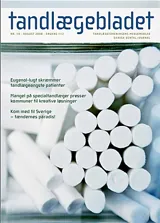Botulinumtoksin i odontologien
De seneste år er tandlæger blevet opmærksomme på lægemidlet botulinumtoksin fra omtale i medier, og fordi internationale fagtidsskrifter i stigende grad publicerer artikler om emnet. Der er dog ikke mange tandlæger, som i dag kender til indikationerne for medicinsk anvendelse af botulinumtoksin i det orofaciale område, botulinumtoksinets virkningsmekanisme eller selve behandlingen, som i Danmark forestås af speciallæger. Artiklen er et uddrag fra en bacheloropgave med titlen Botulinumtoksin (1). Bacheloropgaven behandler dels botulinumtoksin generelt og dels som præparat til alternativbehandling af habituelle luksationer i kæbeleddet. Det odontologiske fokus i denne artikel er flyttet fra de habituelle luksationer til hele det orofaciale område. Botulinumtoksinets virkningsmekanisme, bivirkninger og indikationer vil blive beskrevet.
Klinisk relevans:
Botulinum toxin in dentistry: In recent years the interest for botulinum toxin has increased. Botulinum toxin has been found to alleviate a variety of conditions in the orofacial area, among these oromandibular dystonia and hyperhidrosis. Botulinum toxin inhibits the release of acethylcholine at the presynaptic membrane of cholinergic nerves, thereby reducing muscle activity and secretion. The dentist should be aware of the effects of botulinum toxin and the disorders in the orofacial area that it has been found to treat with success. Because of the few and comparably mild side ef- fects reported and the long-lasting effect, botulinum toxin is considered a valuable alternative to other, existing treatments.


